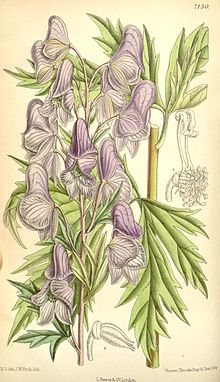Aconitum fischeri: Difference between revisions
Content deleted Content added
TelosCricket (talk | contribs) adding bit of ecology |
→Aconitum fischeri: Fixed typo, Fixed grammar, sd Tags: Mobile edit Mobile app edit Android app edit |
||
| Line 1: | Line 1: | ||
{{short description|Species of flowering plant}} |
|||
{{speciesbox |
{{speciesbox |
||
|image = Aconitum fischeri.jpg |
|image = Aconitum fischeri.jpg |
||
| Line 7: | Line 8: | ||
}} |
}} |
||
'''''Aconitum fischeri''''' is a |
'''''Aconitum fischeri''''' is a species of flowering plant of the genus ''[[Aconitum]]'', in the buttercup family, [[Ranunculaceae]]. It is native to Korea and Siberia and cultivated in gardens in temperate zones for its showy flowers. Plants bloom from early to late summer. The plant contains poisonous [[aconitum|aconite]], but according to ancient Chinese medical lore, if it is carefully measured, prepared, and used, it is believed to be beneficial in the treatment of colds, coughs, and fevers. If the measuring is in the slightest degree inaccurate, however, it is pure poison.<ref>Pearl S. Buck, "The Three Daughters of Madame Liang," London: Moyer Bell, 1969, p. 220.</ref> The plant is susceptible to downy mildew caused by the oomycete species ''[[Peronospora aconiti]]''.<ref name=Constantinescu>{{cite journal |last1= Constantinescu |first= O. |title= An annotated list of ''[[Peronospora]]'' names |date= 1991 |journal= Thunbergia |volume= 15}}</ref> |
||
==References== |
==References== |
||
Revision as of 06:53, 17 January 2021
| Aconitum fischeri | |
|---|---|

| |
| Scientific classification | |
| Kingdom: | Plantae |
| Clade: | Tracheophytes |
| Clade: | Angiosperms |
| Clade: | Eudicots |
| Order: | Ranunculales |
| Family: | Ranunculaceae |
| Genus: | Aconitum |
| Species: | A. fischeri
|
| Binomial name | |
| Aconitum fischeri | |
Aconitum fischeri is a species of flowering plant of the genus Aconitum, in the buttercup family, Ranunculaceae. It is native to Korea and Siberia and cultivated in gardens in temperate zones for its showy flowers. Plants bloom from early to late summer. The plant contains poisonous aconite, but according to ancient Chinese medical lore, if it is carefully measured, prepared, and used, it is believed to be beneficial in the treatment of colds, coughs, and fevers. If the measuring is in the slightest degree inaccurate, however, it is pure poison.[1] The plant is susceptible to downy mildew caused by the oomycete species Peronospora aconiti.[2]
References
- ^ Pearl S. Buck, "The Three Daughters of Madame Liang," London: Moyer Bell, 1969, p. 220.
- ^ Constantinescu, O. (1991). "An annotated list of Peronospora names". Thunbergia. 15.
